China’s digital diplomacy in Latam 2021: back to normal
Illustration by Alonso Gañan.
INTRODUCTION
To analyze the evolution of the digitization of the public diplomacy of the People’s Republic of China (PRC) in Latin America and the Caribbean (LAC), the Andrés Bello Foundation presents this new study, focusing on the dynamics of the Twitter accounts of China’s representatives and diplomatic representations in the region for 2021. The study also offers comparative notes on the findings of the study conducted for 2020 [1].
A combination of quantitative and qualitative methods were used for the study. The applications “Twitter Advanced Search,” “Twitonomy,” and “Followerwonk” were used to collect statistical data from each of the Twitter accounts for the quantitative aspect. For the qualitative aspect, content analysis was used to identify the most relevant topics and their discursive approach.
Of the 25 diplomatic representations of the PRC in Latin America and the Caribbean[2], only 20 have Twitter accounts[3]. The final result for 2021, including diplomatic representations and representatives, is a total of 35 accounts, of which two (the account of the ambassador in the Bahamas, Dai Qingli – @DQingli – and that of the embassy in Suriname – CHNEmbSuriname -) showed no activity during the study period. Two other accounts (the account of the embassy in Trinidad and Tobago – @ChineseEmbinTT – and the first account set up on behalf of the ambassador in Venezuela – @Li_ Baorong -) showed minimal activity.
Finally, a combination of both methodologies was used to create the content categories used in the study. According to the data collected for 2021, the categories were modified as compared to the study conducted and published for 2020. These new categories were also applied to the consolidated results for 2020, allowing us to perform the comparative analysis.
Find out more about the methodology used in this paper.
For an explanation on digital diplomacy and how to understand it in the framework of public diplomacy, and in turn provide a contextualization of the development and characteristics of PRC public diplomacy, please refer to the study for the first half of 2020.
Development of the People’s Republic of China’s digital diplomacy in Latin America and the Caribbean in 2021
By the end of 2021, the PRC had 25 embassies and 26 consulates distributed among the 33 countries that make up the Community of Latin American and Caribbean States (CELAC). As illustrated in the following table, among the diplomatic representations (embassies and consulates), 64% and 11% have a Twitter account, and among diplomatic representatives (ambassadors and consuls) 48% and 8%, respectively.
Six new Twitter accounts were set up in 2021, adding to the 28 accounts that already existed for 2020. These new accounts are:

@DQingli: Dai Qingli, PRC ambassador to the Bahamas

@WeiHongtian: Wei Hongtian, PRC ambassador to Granada

@EmbChinaMex: PRC Embassy in Mexico

@EmbChinaVen: second account belonging to Li Baorong, PRC ambassador to Venezuela[4].
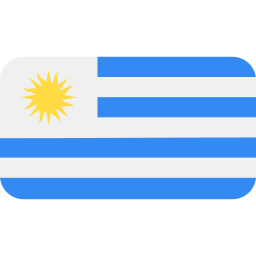
@embajadorcn_uy: Wang Gang, PRC ambassador to Uruguay

@EmbChinaPa: PRC Embassy in Panama.
Creation date of PRC Twitter accounts in LAC – 2021
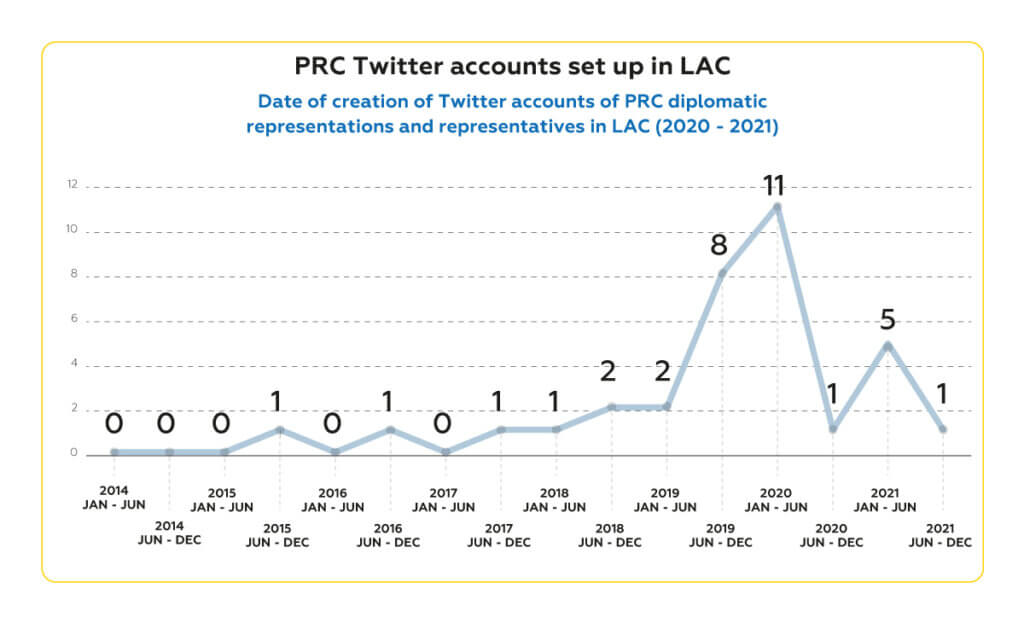
It is important to note that for 2021, two new accounts were incorporated into the study, but these had been set up on an earlier date:
- @Consul_Wan: Penélope Wan, Consul of the PRC in Panama. The account was created in February 2017 but was first used in November 2021.
- @MaHuiChina: Ma Hui, PRC ambassador to Cuba. The account was created in October 2019 but first used in July 2021.
It is also worth mentioning the Twitter accounts that are no longer part of the study since the representative has left the post:
- @DrZhaoyongchen: Zhao Yongchen, PRC ambassador to Granada until the end of 2020.
Click here to view the table of account creation dates
Observing the trend in the creation of Twitter accounts by PRC representations and diplomatic representatives in LAC, there is a growing trend which began in 2019 with a total of 10 accounts set up. This indicates the PRC’s interest in expanding its digital diplomacy. However, the number of new accounts set up and the content produced increased the most in 2020. Of the 12 accounts recorded for that year, 11 were set up during the first half of the year alone. As demonstrated in the study conducted for 2020, this clearly shows the impact that the Covid-19 pandemic had on the PRC’s image, creating the need to strengthen the digitization of its public diplomacy and expand its scope.
Although the number of new accounts set up in 2021 decreased with respect to the previous year, the trend continues to grow. The above indicates that, on the one hand, the PRC’s interest in expanding and strengthening its digital diplomacy in LAC continues. On the other hand, the impact of the favorable evolution of the health crisis following the global containment measures, together with the accelerated development and distribution of vaccines against covid-19 —a matter in which the PRC played an important role— is beginning to lead to some relief with respect to the negative impact on its image worldwide.
Verification and government label of PRC Twitter accounts in LAC – 2021
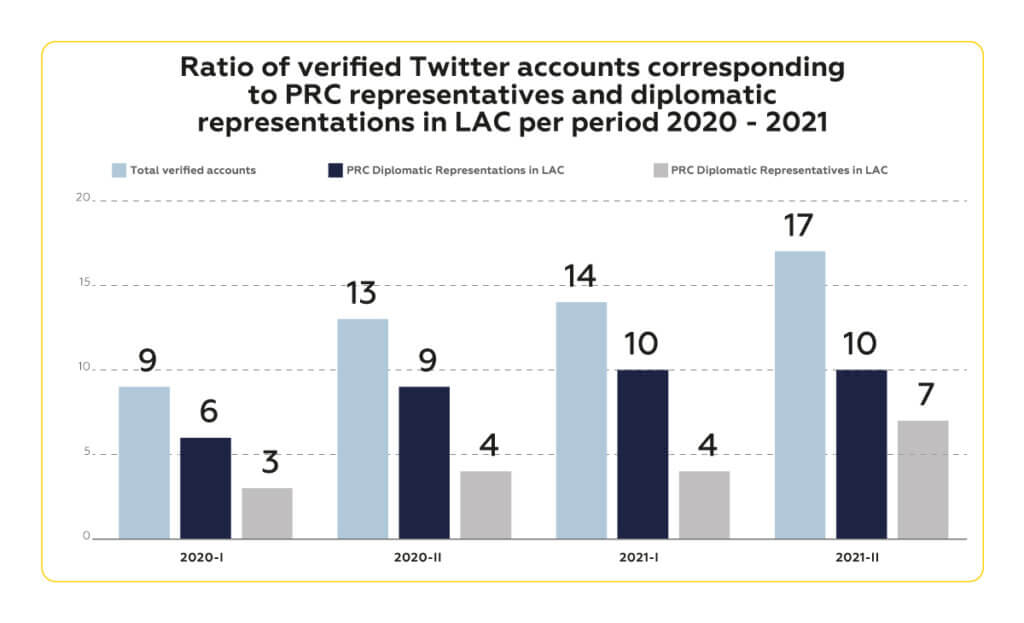
Of the 35 accounts of PRC representatives and diplomatic representations in LAC for 2021, 17 requested and obtained the Twitter verified “blue badge.” This figure represents 48% of the total number of accounts, which, compared to the 46% registered for 2020 is still low, especially considering that verification is a mechanism of authenticity that builds trust among users, which can help strengthen communication with foreign audiences, this being one of the main objectives of public diplomacy.
It is important to note that of the 17 accounts, 10 belong to representations and 7 to diplomatic representatives. According to the figure above, the trend recorded since 2020 in which the largest number of verified accounts belong to diplomatic representations is maintained. However, the trend for 2021 shows a minor uptick in the verification of the accounts of diplomatic representatives, meaning there is greater interest in obtaining the “blue badge.”
Government and state-affiliated media account labels[6]
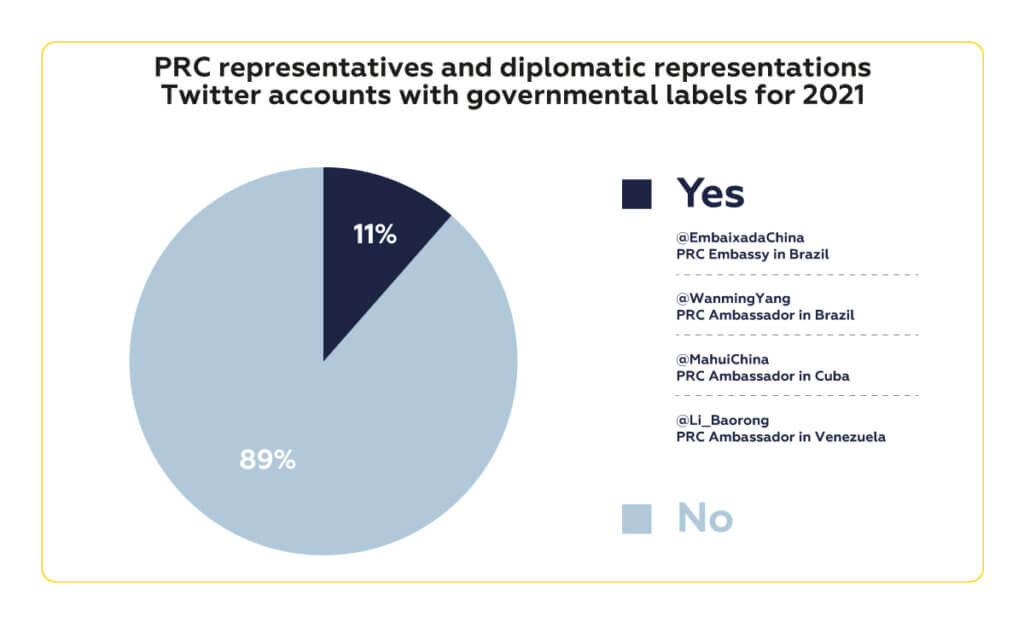
The introduction of Twitter’s government state-affiliated media account label in August 2020 is part of its transparency policy, intended to provide greater transparency regarding the nature of the accounts with which people interact on the platform. The measure initially began to apply to accounts related to government entities, state-affiliated media, and their representatives belonging to the five-member countries of the United Nations Security Council: the United States, France, the United Kingdom, Russia, and China.
Twitter emphasizes the PRC government’s blocking of access to its platform within its territory[7]. However, of the 35 accounts analyzed, only 4 have the government and state-affiliated media account label:
- @EmbaixadaChina: PRC Embassy in Brasil
- @WanmingYang: PRC ambassador to Brasil
- @MahuiChina: PRC ambassador to Cuba
- @Li_Baorong: PRC ambassador to Venezuela
Looking closely at the particularities of these four accounts and comparing them with the rest, beyond the fact that the accounts belong to representatives and diplomatic representations of the PRC and that they are all verified, it is not clear what criteria is needed for the allocation of the government and state-affiliated media account label. Is it the number of followers, as is the case of the accounts of the diplomatic representation and representatives in Brazil who have the highest number of followers? Or is it just the PRC diplomatic representatives in countries in the region whose governments have autocratic tendencies, such as Cuba and Venezuela? Regardless, this is an indication that Twitter does not apply its tagging policies equally to the accounts of Chinese representatives and representations in the region.
PRC Twitter account activity in LAC – 2021
In 2021, account activity appeared to decrease compared to the previous year. However, as illustrated in the graph, this activity grew in a smooth and sustained manner throughout 2021.
As revealed in the 2020 study, the Covid-19 health emergency had a significant impact on the creation and activity of PRC accounts in LAC. The first peaks of activity were closely related to the most difficult months following the World Health Organization’s declaration of the pandemic, reflecting a reactive position given the context and the multiple accusations faced by the Asian country regarding the origin of the virus and its management of the pandemic. However, towards the second half of 2020, when the health crisis began to improve after the global confinement measures, the activity of the accounts began to show a decline and a discursive shift towards a more proactive stance. Although they continued to defend the country against the ongoing accusations, they opted for a more open discourse focused on the economic, technological, and cultural promotion of the Asian country, and on the constant defense and promotion of international solidarity and multilateralism in the face of the U.S. presidential elections in November of that year.
As shown in the graph, the trend continued in 2021 exhibiting increasing stability and balance between account activity and contents. According to content analysis of the tweets, for this year, the most relevant topics seek to promote the PRC worldwide. On the one hand, there is a strong emphasis on the technological advances and achievements materialized in the development and promotion of vaccines against Covid-19 and the success of the space mission to Mars “Tianwen – 1”[8]. On the other, much of the content also addresses the celebration of the 100th anniversary of the Chinese Communist Party, its achievements and progress, particularly in the reduction of extreme poverty.
The two trends that characterize the PRC’s public diplomacy are evident throughout the two years. First, the reactive tendency that obeys the need to defend and protect the national image internationally, which was clear in the context of the accusations against China concerning the origin of the Covid-19 virus. And second, the proactive trend, which marks much of the accounts’ activity in line with the image of a strong, supportive, and cooperative partner that the PRC wants to project worldwide.

Most active accounts: 2020 and 2021 comparison
The most active accounts for 2020 and 2021, for the most part, belong to PRC diplomatic representatives in LAC. The following graph shows that the notable exception is the PRC Embassy in Brazil (@EmbaixadaChina) which for 2020, ranks third among the top five accounts with the highest activity.
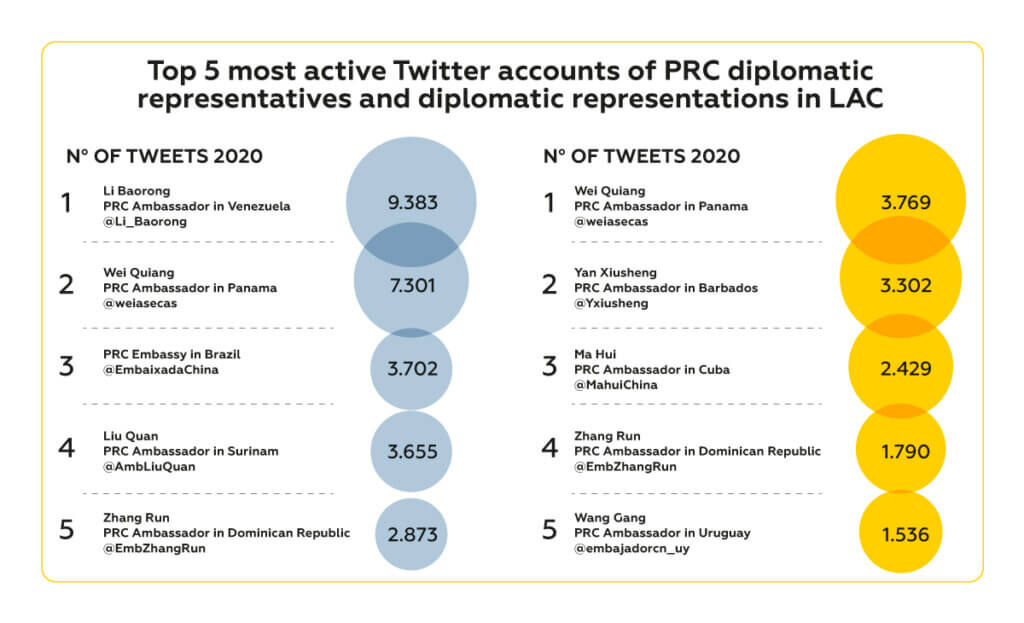
This unusual behavior is the result of the tensions that arose throughout 2020 in relations between the two countries due to the various accusations made against China by Brazil’s President, Jair Bolsonaro, and other senior officials of his government. In the context of the Covid-19 pandemic —following the discursive line of the then President of the United States, Donald Trump—, they accused the Asian country of being responsible for the origin of the virus[9].
Both the ambassador Wanming Yang (@WanmingYang) and the PRC Embassy in Brazil (@EmbaixadaChina), spoke out in strong protest in response to the accusations. But in the case of the embassy’s account, there was a significant increase in its activity compared to that of the ambassador. The content of the tweets emphasized not only the opposition to the attacks against China, claiming that they encourage confrontation rather than cooperation, but also the need to build a model of international relations centered on solidarity and cooperation. These tweets went hand in hand with other tweets promoting the PRC, from its economic achievements in the framework of poverty reduction policies to its progress in science, technology, and innovation. The foregoing showed the two types of approach —reactive and proactive— that characterize its public diplomacy.
For 2021, the accounts of the diplomatic representatives remain the most active. Here it is worth making two clarifications. The first concerns the account of the Ambassador to Venezuela (@Li_Baorong), which was the most active in 2020, but does not record any activity for 2021. This is due, as explained in previous sections, to the suspension of his account for that year. The second concerns the inclusion in the list of two diplomatic representatives who assume office as ambassadors in 2021: the ambassador to Cuba, Ma Hui (@MahuiChina), and the ambassador to Uruguay, Wuang Gang (@embajadorcn_uy).
Distinctive aspects of the followers and accounts followed by PRC representatives and diplomatic representations in LAC – 2021[10]
Of the 35 accounts analyzed in 2021, 9 (26%) have between 1 and 1,000 followers. When compared to 2020, 12 of the 28 accounts (43%) had a similar range of numbers of followers. Moving up, of the 35 Twitter accounts analyzed, 26 (77%) have between 1,000 and 100,000 followers. This figure is significant if we consider the variation with respect to 2020, when only 16 of the 28 registered accounts (57%), were in the same bracket of followers.
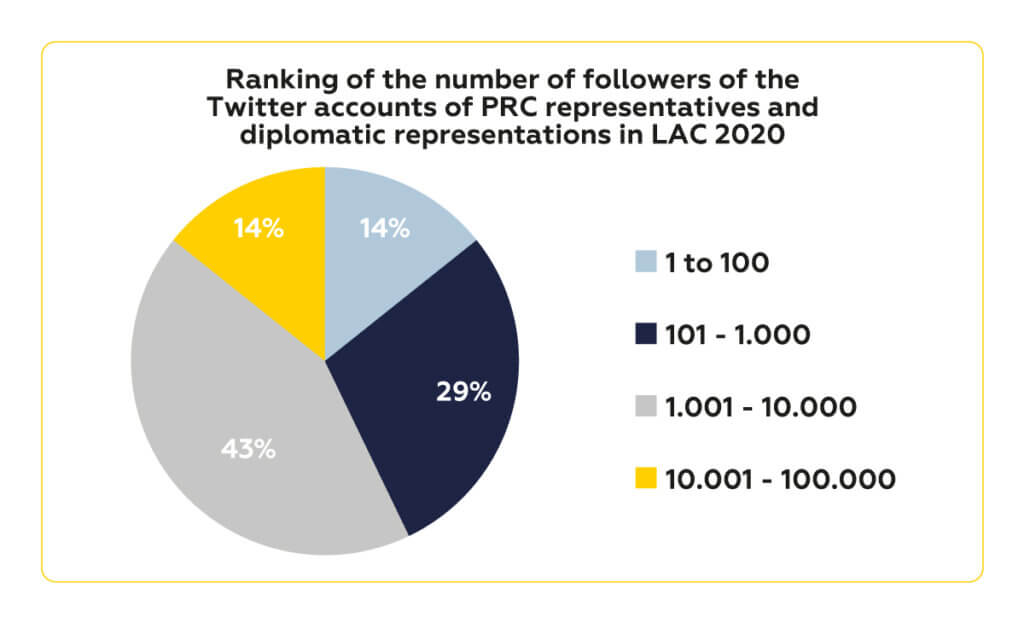
We can see that as the number of accounts of PRC representatives and diplomatic representations in LAC increased between 2020 and 2021, so did the number of their followers, thus amplifying their scope and interaction with foreign audiences.

Ranking of the number of followers 2021
Among the top 10 Twitter accounts of PRC diplomatic representatives and diplomatic representations in LAC with the highest number of followers by 2021, 6 of these accounts belong to diplomatic representatives and 4 accounts belong to diplomatic representations.
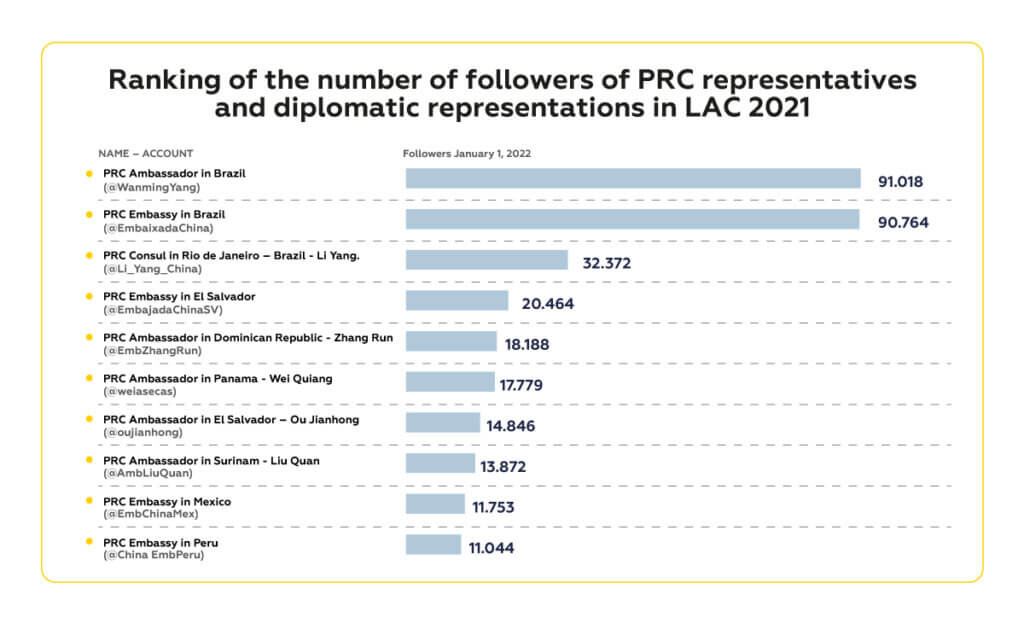
Characteristics of followers and followed accounts
To analyze the data for 2021, new categories were adjusted and created according to the type of information found. These new categories were also applied to the 2020 consolidated data in order to perform the comparative analysis. For a description of each of the categories see the attached list. Click here to view categories.
Georeferenced origin of accounts
Using the georeferencing application provided by Followerwonk, it was found that of the 35 accounts belonging to PRC diplomatic representations and representatives in LAC, 26 of them had a majority of followers based in the host country of the diplomatic mission, while the other 9 had a high number of followers georeferenced in other locations, within the PRC. These 9 accounts belong mostly to embassies and ambassadors in the Caribbean:
- @ChinaEmbAntigua: embassy in Antigua and Barbuda
- @DQingli: Ambassador in Bahamas
- @YXiusheng: Ambassador in Barbados
- @Li_Yang_China: Consul in Rio de Janeiro (antes @CGChinaLiYang)
- @MahuiChina: Ambassador in Cuba
- @ChinaEmbGrenada: embassy in Granada
- WeiHongtian: Ambassador in Granada
- @CHNEmbSuriname: embassy in Surinam
- @AmbLiuQuan: Ambassador in Surinam
It was also found that the majority of the accounts followed by PRC representatives and diplomatic representations in LAC (26), follow users whose reference location falls within the host country of the diplomatic mission, while 8 of these follow users whose reference location is within the PRC:
- @Li_Yang_China: Consul in Rio de Janeiro (antes @CGChinaLiYang)
- @MahuiChina: Ambassador in Cuba
- @ChinaEmbGrenada: embassy in Granada
- @WeiHongtian: Ambassador in Granada
- @CHNEmbSuriname: embassy in Surinam
- @AmbLiuQuan: Ambassador in Surinam
- @embajadorcn_uy: Ambassador in Uruguay
- @EmbChinaVen: Ambassador in Venezuela (cuenta nueva)
It should be noted that, of all the accounts, the one belonging to the ambassador in Bahamas, Dai Qingli (@DQingli), does not follow any other Twitter account.
Types of followers’ accounts – 2021
For 2021, we found that the largest number of followers corresponds to the “Citizens” category which not only reflects a significant interest of the foreign public in the accounts of PRC diplomatic representations and representatives in LAC, but also creates optimal conditions for strengthening communication with them in the context of public diplomacy.
Secondly, we found three categories that are of great interest for future advances in the development of this research: “PRC or Taiwan Citizen,” “Content Amplifier,” and “Bot.” These three categories occupy an important place among the followers of the accounts, and, although there is no evidence that they obey astroturfing dynamics[11] –which allow discursive control and amplification- such as those that have been detected within the PRC and highlighted in different studies[12], it is possible that the same type of practices may be applied internationally. But, as has been pointed out, further research is needed to obtain evidence in this respect.
In third place is the “PRC Government” category, which includes accounts belonging to the Ministry of Foreign Affairs and its spokespersons; diplomatic representations and representatives both in LAC and in other countries; and the accounts of other government bodies and territorial entities, and their spokespersons. This category in part is evidence of that precise guidance by the PRC government in what has been one of its main driving principles of public diplomacy: telling China’s story well.
In fourth place are the categories “LAC Research and Higher Education Centers” and “Foreign Research and Higher Education Centers,” which reveal academia’s growing interest —particularly at the regional level in LAC— to broaden and deepen their studies on the Asian giant.
Finally, in fifth place, we have the “Private Accounts” category, which could be considered to be made up of ordinary citizens, who are considered in this research as a foreign audience, but since their accounts are private, it is not possible to ascertain their status as such.
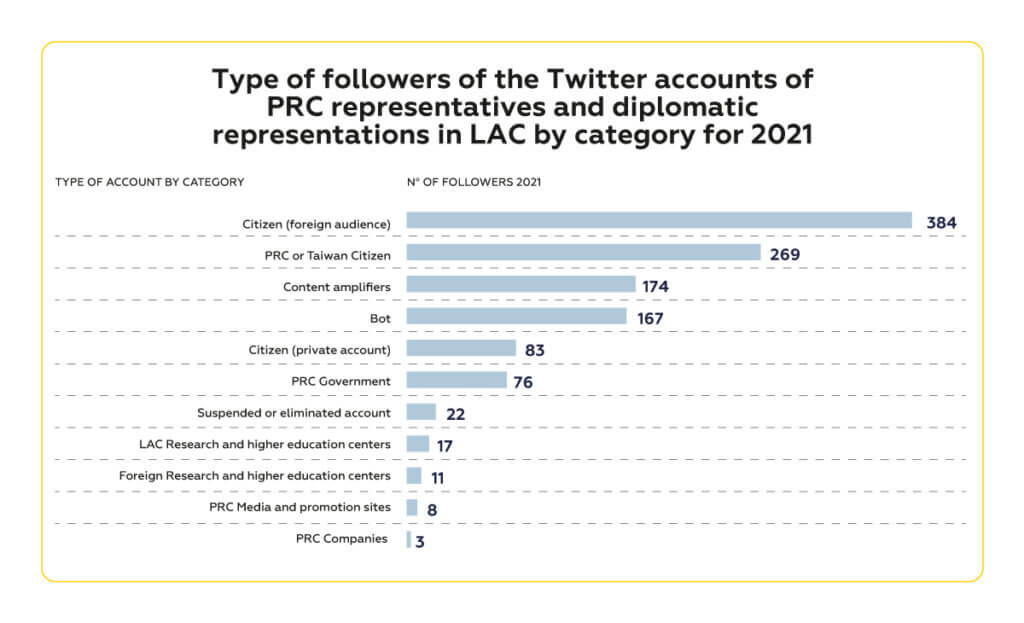
According to the following graph, comparing the above analysis with the research results for 2020, the trend has clearly been maintained, with only slight variations between the two years, for all five main categories.
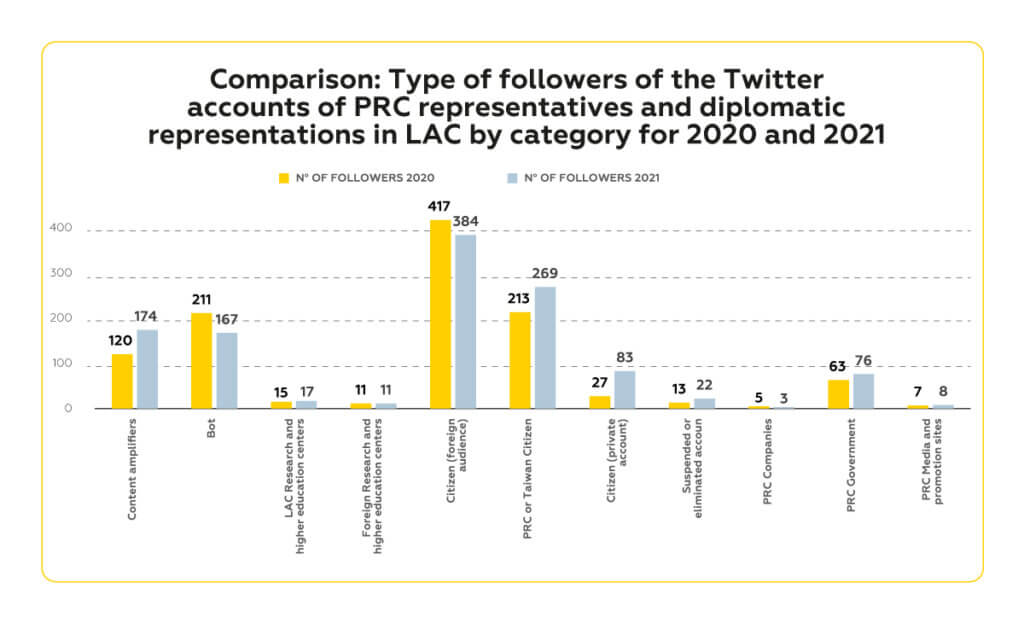
Types of accounts followed – 2021
For 2021, we found that the highest number of accounts followed are, 1) the “PRC Government” category, and 2) the “PRC Media and Promotion Sites” category. This demonstrates the government’s adherence to precise guidelines regarding the management and safeguarding of its international image.
This is followed by the categories “LAC governments and territorial entities,” showing an effort to strengthen ties with the regional governments; and “Multilateral organizations, forums and spaces,” reflecting the reinforcement of the defense of multilateralism as one of the main elements of its foreign policy.
Finally, we have the “Foreign media” category, which shows the need to know what kinds of narratives exist about the country abroad.
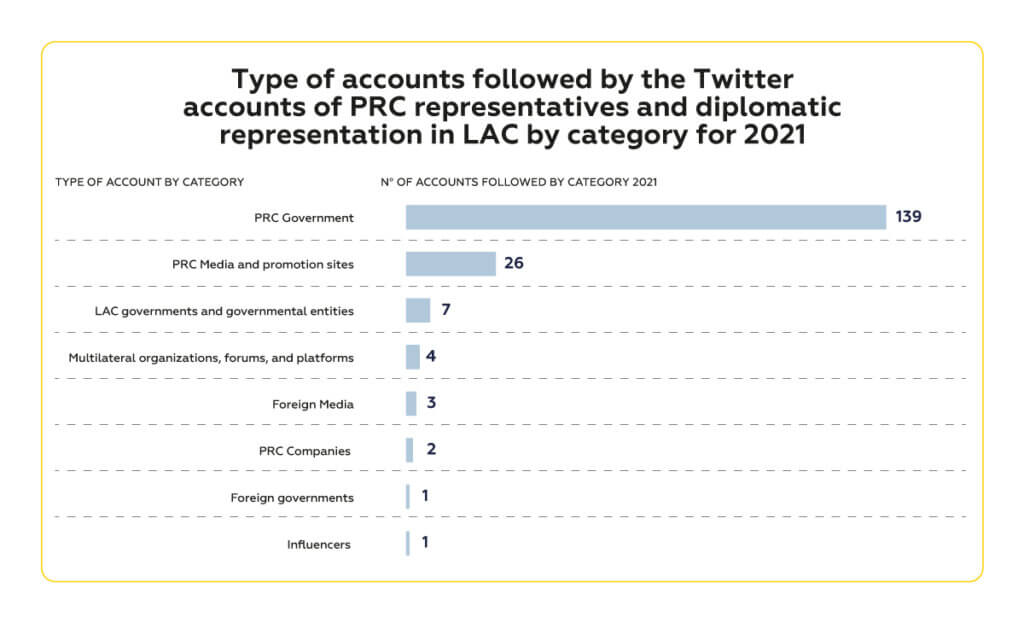
When examining the results of the categories in the analysis for 2021 and comparing them with the year 2020, as shown in the following graph, we find that the first two, i.e., “PRC Government” and “PRC media and promotion sites” rank first with respect to the accounts followed by PRC representations and diplomatic representatives in LAC. This, as discussed above, is evidence of the control over the narrative about China’s image that it seeks to exert.
Also among the first five places are the categories “International organizations, spaces, and forums,” which, as previously stated, is due to the importance of defending multilateralism within its foreign policy; and “Foreign media,” which reflects the need to know the international narratives about China.
Finally, we have that by 2020, PRC accounts in LAC appeared to be more interested in following accounts belonging to the categories of “Foreign governments” and “Influencers,” and not so much in accounts belonging to the “LAC governments and governmental entities” category. This may be due to the need for a broader view of the type of narratives about China that may exist worldwide in the context of the Covid-19 pandemic.
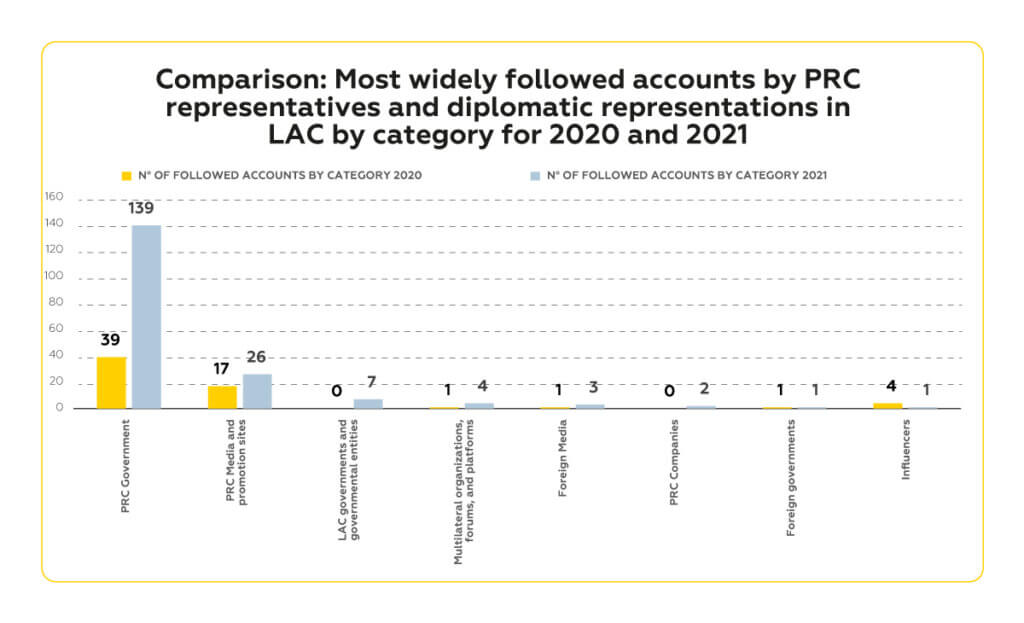
Interactions of PRC representatives and diplomatic representations in LAC via Twitter for 2021[13]
Most frequently retweeted users 2021
For 2021, retweet behavior is in line with the general trend towards decreasing account activity. However, among the different types of account interaction, retweets are the most numerous, ahead of mentions and replies.
As illustrated in the following graphs, the categories of users with the highest number of retweets are “PRC Government” and “PRC media and promotional sites.” This is not surprising, since the role of retweets is to amplify specific content, and since these categories are precisely the ones with the highest number, it only reinforces the trend seen regarding the PRC Government’s priority in the management of its public diplomacy: to be the main guide and voice in protecting its international image.
Also, the “LAC governments and governmental entities” and “LAC media” categories continue the trend seen in 2020 as a result of the material and immaterial cooperation that the PRC provided to the region in the context of the Covid-19 pandemic, but which, for 2021, is expanded, emphasizing the advantages and strengthening of relations between China and LAC. This is also evident in the increase of retweets in the “LAC private companies and organizations” and “PRC-LAC binational organizations” categories. Thus, both in 2020 and 2021, the country’s goal was to proactively appear as a peaceful and reliable partner for LAC countries.
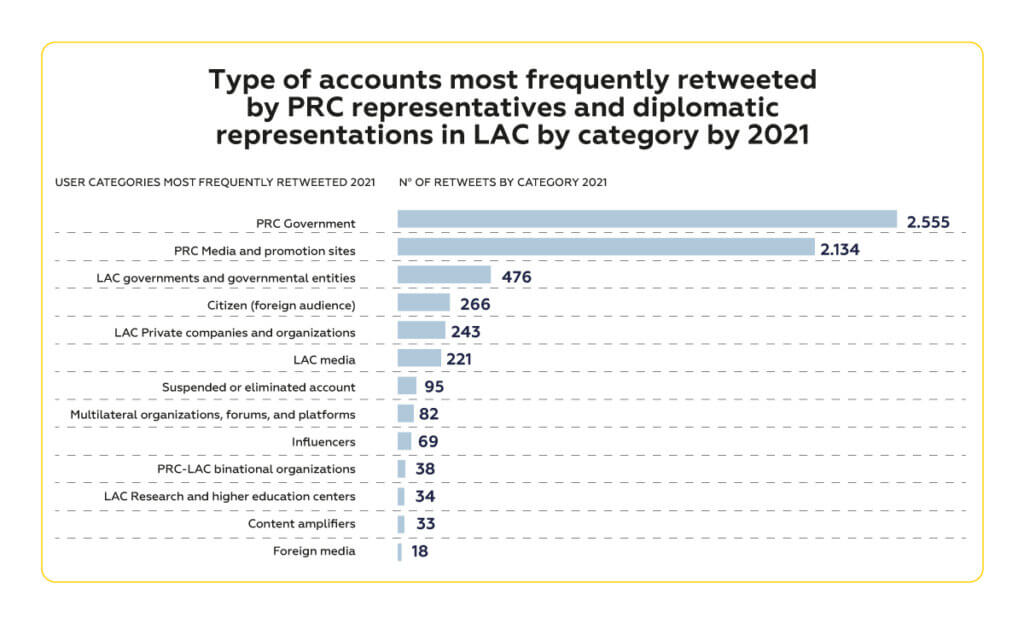
Internationally, the importance of defending multilateralism continues to be highlighted through the retweets of the accounts belonging to the “Multilateral organizations, forums, and spaces” category. Likewise, local voices in favor of China are also amplified in retweeting “Foreign media” and “Influencers” who report or comment on positive aspects of China and its relationship with the country in question.

Most frequently mentioned type of users 2021
The categories corresponding to the most frequently mentioned users for 2021, maintain the trend seen since 2020 and revealed through the different items of analysis in this study. Bearing in mind that the purpose of the mentions is to involve one or several users in the same conversation on a specific topic and thus amplify its scope, there are two elements to highlight: on the one hand, the high number of mentions to users in the “LAC governments and government entities” category, which continues to focus on expanding and strengthening China’s relations with each country in the region, emphasizing its image as a peaceful and reliable partner; and, on the other hand, the high number of mentions to accounts belonging to the “PRC media and promotion sites” and “PRC government” categories, which serve the same purpose.

A relevant piece of information observed since 2020 and which is strengthened for 2021 is the number of mentions obtained by users in the “Citizens” category, which is the central axis of public diplomacy. his category is the central axis of public diplomacy. Accordingly, having an important number of mentions, shows a greater interest in strengthening this communication with the foreign public.
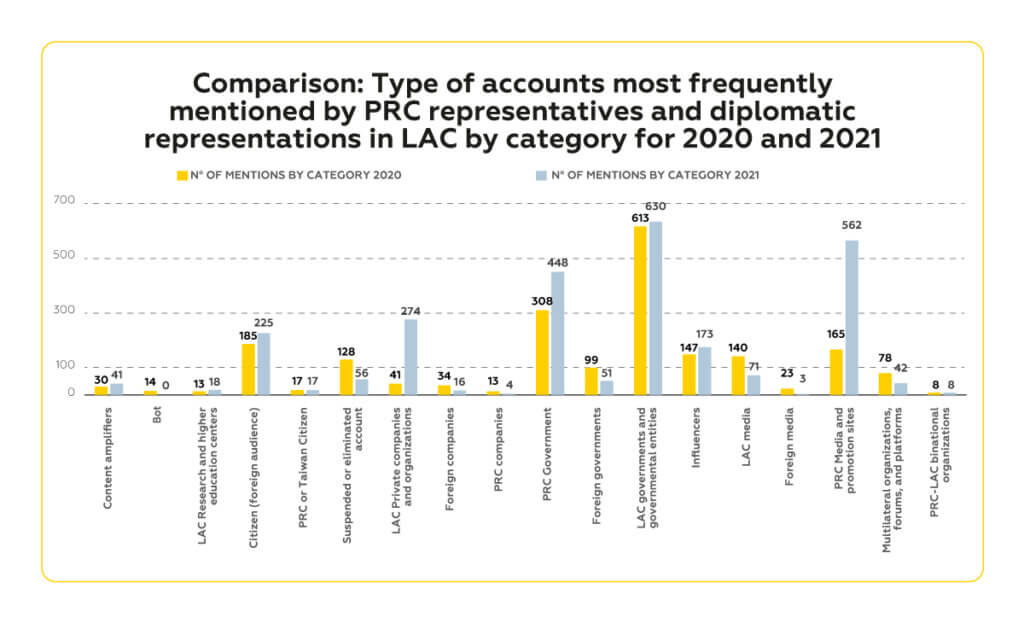
Type of users with the highest number of replies – 2021
Following the same trend as for 2020, in 2021, the predominant category for the most frequently retweeted users is “PRC Government.” Although the use of replies on Twitter is intended to engage in conversation with other users, i.e., a two-way communication, the discursive dominance of official sources is once again apparent. However, it should be noted that the predominance of this category is attributable to the fact that the accounts of both representatives and diplomatic representations respond to themselves without using the “thread” modality used on Twitter to disseminate information in consecutive tweets.
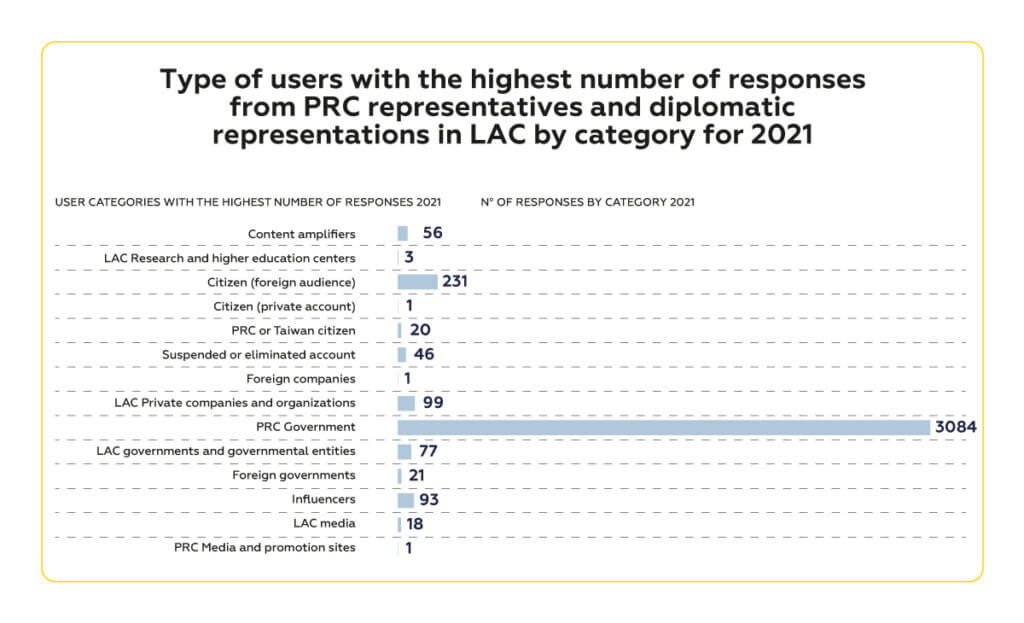
In a distant second place is the “Citizen” category, thus breaching the paradigm of the previous sections regarding the characteristics of PRC public diplomacy and its unidirectional nature. However, although this is evidence of a dialogue with the foreign audience, which is the main objective of public diplomacy, the levels of interaction are only incipient.
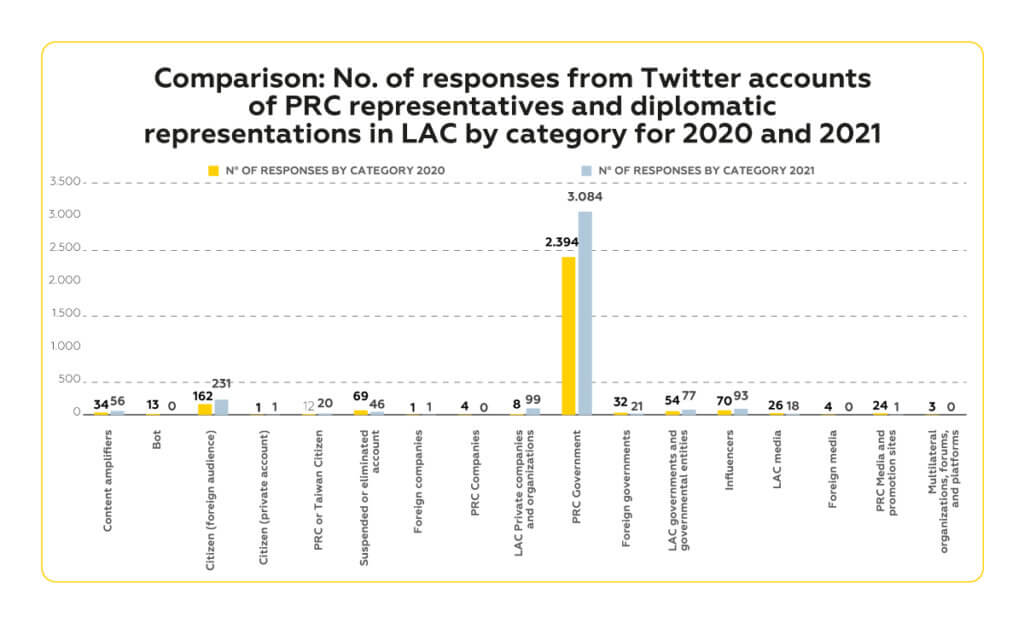
Most frequently used hashtags 2021
To analyze the data for 2021, new categories were adjusted and created according to the type of information found on the labels. These new categories were also applied to the consolidated data for 2020 for comparative analysis. Click here for a description of each of the categories.
The main purpose of hashtags is to highlight and amplify the scope of a topic on the platform. As illustrated in the following graphs, in 2021, the same categories of hashtags are predominant as in 2020. The “Covid-19” category, continues to occupy an important place, although for 2021, it places special emphasis on the development and distribution of vaccines globally. This year’s “PRC promotion” category goes beyond the practices that allowed the containment of the virus in China and extends to the country’s widespread promotion of areas such as policies for economic recovery, technological advances, cultural heritage as world heritage, and tourism. The “Binational relations” category, which initially focused on binational cooperation for the containment of the pandemic, later placed greater emphasis on encouraging the consolidation of China’s economic, political, and cultural relations with LAC.
Other important categories during the two years, include “International solidarity and South-South cooperation,” which emphasizes the role of the PRC in creating international solidarity ties, and strengthening cooperation in the global south; the “Multilateral organizations, forums, and spaces” category, which refers to the support, cooperation, and strengthening of multilateralism; the “USA” label, which refers to China’s relations with the United States, particularly the tensions between the two countries.
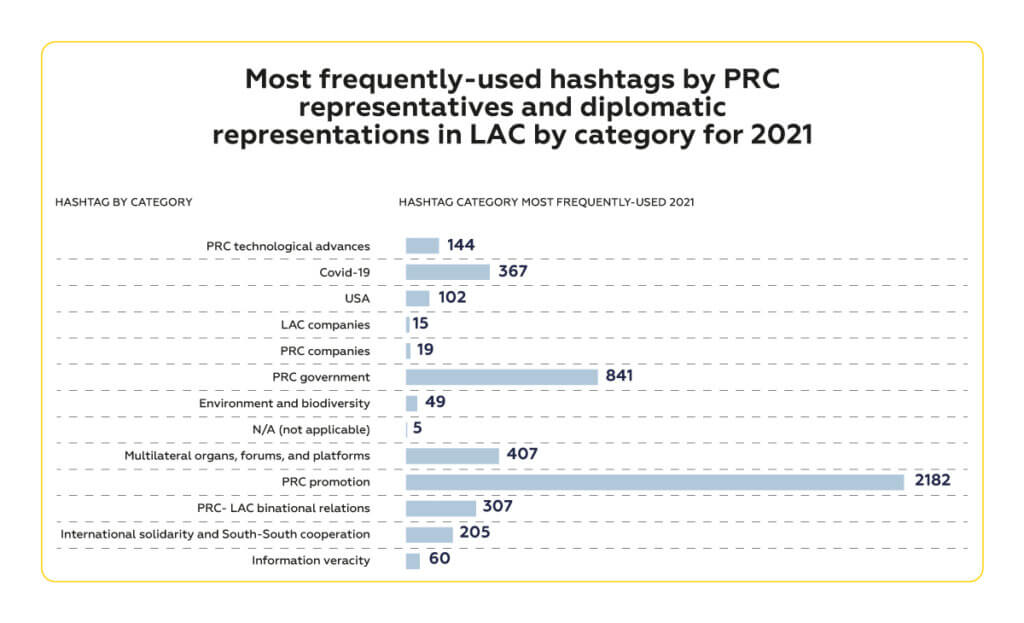
Finally, for 2021, it is worth highlighting the relevance of the “PRC Government” category, which places special emphasis on the success of domestic policies for poverty reduction, as well as the celebration of the 100th anniversary of the Chinese Communist Party and its main achievements; the “Environment and biodiversity” category, whose activity increases, giving greater relevance to China’s commitment and policy development and its global advocacy to protect the environment and biodiversity.

CONCLUSIONS
The consolidated analysis of the Twitter accounts belonging to the representatives and diplomatic representations of the PRC in LAC for 2021 and its comparison with the previous year, indicates a consolidation of the digitization of its public diplomacy. It also reveals the development of a more balanced trend both in the creation and activity of the accounts as well as in their discursive content. While the 2020 study indicated accelerated growth and a more reactive discourse, the 2021 study showed a trend towards a more proactive discourse, accompanied by a smooth and sustained growth in both account creation and activity.
The main guideline of the PRC’s public diplomacy was also evident: the protection, defense, and promotion of its image worldwide. The content analysis of each of the accounts and the dynamics found in the type of accounts followed, retweets, most frequently mentioned users, and those with the highest number of replies, clearly show the PRC government’s adherence to this precise guideline regarding the projection of its image focused on the principle of telling China’s story well.
By analyzing the activity of the accounts, the relationship with the content of the tweets and the use of hashtags, we were able to confirm the two characteristic elements of its public diplomacy, which frame the main guidelines of its foreign policy. On the one hand, the proactive approach, which favors an image of China as supportive, peaceful, cooperative, and respectful; and, on the other, the reactive approach, intended to correct distortions of this image and to counteract international criticism of domestic policies.
Concerning communication with foreign audiences, the main objective of public diplomacy, it must be said that the PRC seems to overlook the interactive potential of the two-way communication pursued using the Twitter platform. This may be due to the marked interest in maintaining discursive control over China’s image internationally. However, as it became evident for 2020 and for 2021, despite this hybridization in its public diplomacy, in which there is a greater use of digital technologies but communication tends to be unidirectional, a dialogue with the foreign audience is beginning to emerge through the most frequently mentioned users, and those with the highest number of replies.
Finally, it is important to continue to deepen the analysis of the PRC’s digital diplomacy in LAC through empirical studies such as this one. This would not only reveal certain elements and principles of its foreign policy —expressed through its public diplomacy—, but its analysis within the regional context would also examine the strengths and weaknesses in the communication dynamics between the PRC and LAC.
Learn about the methodology used in this analysis.
End notes
[1] Micolta, M. (March 3, 2022). 2020: A decisive year the PRC’s digital diplomacy in Latin America and the Caribbean. Andres Bello Foundation – China Latin American Research Center.
[2] On December 9th, 2021, The Republic of Nicaragua broke its longstanding diplomatic ties with Taiwan and officially acknowledged the government of the People’s Republic of China (PRC).
[3] As of 2021, the diplomatic representations in Costa Rica, Dominica, Guyana, Jamaica, and Nicaragua do not have Twitter accounts, nor do their representatives.
[4] Ambassador Li Baorong already had a Twitter account (@Li_Baorong) which was suspended at the end of 2020 due to non-compliance with the platform’s policies. The Ambassador opened his new account, @EmbChinaVen, in May 2021. Thus, both accounts remain in his name, and although the first one was reactivated by the platform, the latter is the one that shows activity. However, for the purposes of this study, both Twitter accounts will be part of the analysis while they are active and Ambassador Baorong is in office in the Bolivarian Republic of Venezuela.
[5] To verify a Twitter account means to confirm its authenticity and applies to those accounts that are of public interest. This interest covers different areas such as journalism, government, music, sports, media, business, and politics, among others. The process is performed at the request of the account user. Source: Twitter.
[6] In accordance with Twitter’s transparency policies, the use of the government tag provides context on those accounts controlled by governments, state-affiliated media, and individuals linked to these entities. Source: Twitter
[7] Find out more about the case of the PRC and the policy on government labels on Twitter.
[8] Méndez, L. (May 15, 2021). Misión ‘Tianwen – 1’ se posa con éxito en Marte y marca un hito en la carrera espacial china. France 24.
[9] Among the accusations made by Brazil´s Government members against China: 5G networks raise China espionage fears after the Launch of The Clean Network program by the Trump Administration’s; Find out more: (Spanish) La Vanguardia. (November 25, 2020). China vuelve a protestar a Brasil por comentarios del hijo del Bolsonaro. La Vanguardia; Trucco, F. (November 25, 2020). Embajada de China en Brasil rechaza acusaciones de espionaje del diputado Eduardo Bolsonaro. CNN en Español; Galarraga, N. (April 7, 2020). Un ministro de Brasil levanta la ira de China al acusarla de usar el coronavirus en “un plan para dominar el mundo. El País.
[10] The new categories applied to classify the followers and accounts followed by representatives and diplomatic representations of the PRC in LAC should be taken into account. See the Methodology appendix.
[11] In this respect, see: Jerry Zhang, Darrell Carpenter and Myung Ko. (2013). Online Astroturfing: A Theoretical Perspective. Proceedings of the Nineteenth Americas Conference of Information Systems. Chicago, Illinois.
[12] In this respect, see: Gary King, Jennifer Pan, and Margaret E. Roberts. (2017). How the Chinese Government Fabricates Social Media Posts for Strategic Distraction, not Engaged Argument. American Political Science Review, 111(3), 484-501 y Han, Rongbin. (2015). Manufacturing Consent in Cyberspace: China’s ‘Fifty-Cent Army. Journal of Current Chinese Affairs, 44(2), 105–34, among others.
[13] The creation of accounts in social networks, the number of publications, and a significant number of followers are not enough for an effective construction of network communication, and Twitter is no exception. Different options for communicative interaction with other user accounts are indispensable. Twitter includes: retweets (RT), through which an original publication or tweet is shared, and are used to expand the dissemination of the original message and, in most cases, to show support; mentions (@username), which allow direct “contact” with another user; and tags or hashtags (#words or phrases), through which a communication network is created on a given topic.
REFERENCES
Andres Bello Foundation – China Latin American Research Center. (September 13, 2021). 100 años del Partido Comunista de la República Popular China. Available here.
Andres Bello Foundation – China Latin American Research Center. (February 2, 2022). Laureano Ortega signs four agreements with the People’s Republic of China on behalf of the regime. Available here.
Andres Bello Foundation – China Latin American Research Center. (April 7, 2022). La diplomacia de las vacunas de China en América Latina y el Caribe 2021. Available here.
Galarraga, N. (April 7, 2022). Un ministro de Brasil levanta la ira de China al acusarla de usar el coronavirus en “un plan para dominar el mundo.” El País. Available here.
Gary King, Jennifer Pan, and Margaret E. Roberts. (2017). How the Chinese Government Fabricates Social Media Posts for Strategic Distraction, not Engaged Argument. American Political Science Review, 111(3), 484-501. Available here.
Han, Rongbin. (2015). Manufacturing Consent in Cyberspace: China’s ‘Fifty-Cent Army. Journal of Current Chinese Affairs, 44(2), 105–34. Available here.
La Vanguardia. (November 25, 2020). China vuelve a protestar a Brasil por comentarios del hijo del Bolsonaro. La Vanguarda. Available here.
Méndez, L. (May 15, 2021). Misión ‘Tianwen – 1’ se posa con éxito en Marte y marca un hito en la carrera espacial china. France 24. Available here.
Micolta, M. (March 3, 2022). 2020: A decisive year for the PRC’s digital diplomacy in Latin America and the Caribbean. Andres Bello Foundation – China Latin American Research Center.
Trucco, F. (November 25, 2020). Embajada de China en Brasil rechaza acusaciones de espionaje del diputado Eduardo Bolsonaro. CNN en Español. Available here.
Twitter (2022a). Acerca de las cuentas verificadas. Available here.
Twitter (2022b). Sobre las etiquetas en cuentas de medios afiliados al gobierno y al Estado en Twitter. Available here.
Zhang, J., Carpenter, D. and Ko, M. (2013). Online Astroturfing: A Theoretical Perspective. Proceedings of the Nineteenth Americas Conference of Information Systems. Chicago, Illinois. Available here.

